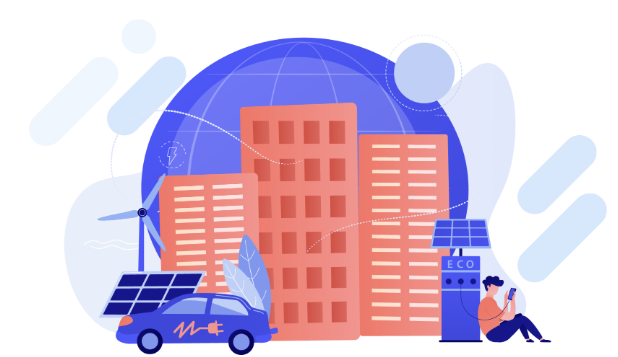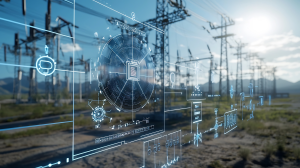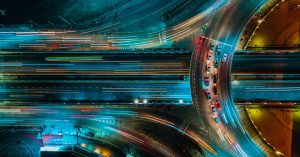The cities of tomorrow should be environmentally responsible and should focus on optimizing resources, designing better spaces, and leveraging technology for people, businesses, and governments to offer an outstanding quality of life. To become this type of city, they must work hand in hand with smart utilities to provide efficient and sustainable services and satisfy emerging community needs. In turn, these modern providers will need to rely on state-of-the-art solutions, like Smartflex, to drive innovative and sustainable strategies.

By 2050, about 70% of the world’s population will live in cities. This type of growth imposes new challenges on governments relating to the energy supply, CO2 control emissions, mobility, health, and safety services of all those residing in these larger populated areas. To face the future effectively, the concept of smart cities was created, depicting a city that relies on technology to become economically, socially, and environmentally sustainable.
These smart cities are constantly working on structural and operational improvements in the following areas:

The challenges of tomorrow's cities
Public services play a central role in a city´s transformation. It’s impossible to imagine a futuristic city with poor electric power infrastructure or a community protected from seasons without quality natural gas services, for example. Most of the needed developments of a modern city, like EV infrastructure, electric public transportation, distribution network upgrades, IoT, and the commitment of its citizens are directly related with the operational improvement utilities are investing in nowadays.
In this sense, smart utilities dedicate their efforts and resources to digitalizing customer processes, especially customer journeys, that impact usage behavior and contribute to the sustainable use of resources. Additionally, customers expect their service providers to guide them to greener practices, offer new products and services, and use emerging technologies to support unique experiences. That is why modern utilities are betting on innovative initiatives to improve energy and service quality, process automation, distributed energy resources, new rate models, and electric vehicles.
Utility companies are on the road to digitally changing their operations to support modern cities. This involves revamping business cycle processes to support new business models, transforming into customer-centric organizations, and incorporating technologies like AMI or AI. Through these changes, they can improve operational efficiency, optimize network resources, and offer new rate programs that encourage energy efficiency and ultimately benefit customers.
Despite the efforts of digitally transforming their business, many utilities remain stuck in the past, using outdated technologies that do not adapt to the dynamics of a smart city. Traditional billing systems make it more difficult to reduce operating costs while improving CX and implementing sustainable initiatives. Service providers also struggle with creating new products and services that compensate for revenue lost from prosumers or sharing platforms, automating event-driven activities efficiently, and providing traceability for process analysis. Moreover, they need to manage large volumes of customer data and ensure metering and billing process quality with a single system to reach the level of agility that the market requires to satisfy new customer demands.
What do smart utilities need?
The first step in digitally evolving your utility is to find modern systems that offer cloud deployment, advanced billing functions extended to event management, and cutting-edge CX capabilities. This new software should leverage AMI technology to take advantage of detailed consumption and device data to offer unique rate plans, enhance customer experience, and improve infrastructure management.
Once they find the ideal solution, these companies will transition from a company focused on providing a service to an intelligent digital utility that responds to advanced business and community challenges. Following their transformation journey, utilities will be able to integrate new technologies into their operation to respond quickly to emerging demands and regulatory requirements. In most cases, they’re not experts in using these types of technologies, which presents an additional challenge. Utilities must look for a technological ally specialized in incorporating emerging technologies into the utility world.
Smartflex, the driving force behind smart utilities
To help the boldest service providers become smart digital enterprises that support the technological, social, and economic revolution of cities, Open Intelligence has created Smartflex, a state-of-the-art billing and customer care solution equipped with innovative capabilities and cutting-edge technologies. This system offers a modern CIS that extends its M2C and C2M capabilities to three dimensions: digital customer experience (DCX), meter data management (MDM), and mobile workforce management (MWM), to cover the critical aspects of utility customer operations.
Thanks to its holistic and modern design, Smartflex is compatible with traditional and smart meters allowing utilities to obtain, manage, and control high amounts of data, like consumption, quality service variables, events, and more. It supports VEE functionalities that improve billing accuracy and consistency across all processes and enable interval information. By offering innovative reporting tools and configurable intelligent workflows, the solution also helps utilities analyze data from different perspectives and trigger automatic response activities, providing agility and increasing productivity.
Smartflex’s architecture offers functionalities and tools that position customers, their needs, and expectations at the core of the operation. To enhance customer service processes, the solution provides an intuitive interface with a 360° view of customers and preconfigured processes, allowing CSRs to obtain a holistic view and a general understanding of each customer to solve their requests, improving first contact resolution. Smartflex also offers a powerful self-management portal that presents relevant and dynamic information to educate customers on their consumption behaviors and guide them in sustainable practices. Additionally, the portal has traditional and advanced features allowing customers to execute processes like payments and program enrollments, just a few clicks away.
One of Smartflex’s newest innovations is proactive interactions, a simple and efficient way that utilities interact and engage with their customers in a personalized manner and anticipate their demands. By analyzing multiple data points and using AI tools like chatbots through instant messaging platforms, utilities stay one step ahead of their customer needs. These capabilities enable service providers to design innovative end-to-end customer journeys that provide unique and satisfying experiences to their customers.
Finally, Smartflex’s flexibility allows utilities to rapidly design and deliver new offers and commercial programs, attracting more customer segments. Thanks to the product and service catalog functionality, service providers can easily transition to greener value propositions, like EVs and prosumers, that satisfy emerging environmentally friendly needs. Additionally, the solution’s advanced rules engine facilitates the configuration of new rate schemes by intervals or time ranges, which supports the service portfolio diversification that providers seek to innovate and capture more value.
To become smart digital organizations and contribute to the development of modern cities, utilities should implement modern, holistic, and cognitive CIS solutions like Smartflex. With a modern solution, all data stays centralized, consistent, online, and shared across the operation. Service providers can respond efficiently to market demands while building innovative capabilities according to customer expectations.
References
[1] Deloitte (March 05, 2019) Renewables (em)power smart cities – Deloitte’s 360-degree smart city framework https://www2.deloitte.com/us/en/insights/industry/power-and-utilities/smart-renewable-cities-wind-solar.html







